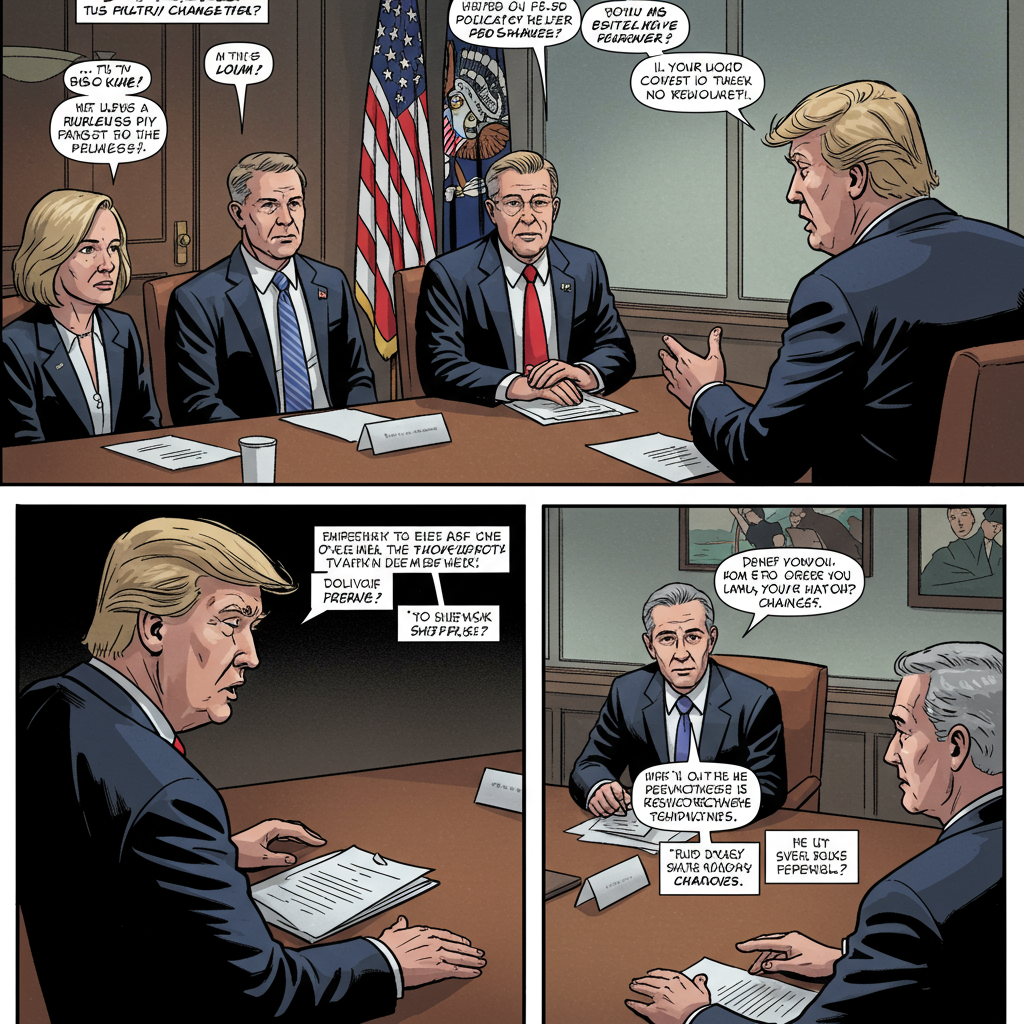Business leaders across the United States face significant apprehension. Uncertainty surrounding potential policy and regulatory changes under the current political climate is prompting many employers to re-evaluate their workplace strategies. From federal labor laws to immigration enforcement and diversity initiatives, companies are grappling with how to anticipate and adapt to a rapidly evolving legal landscape. This environment necessitates a proactive approach to revisiting internal policies and making informed adjustments for the months and years ahead.
The Landscape of Uncertainty for Businesses
A palpable sense of “disquiet” and “regulatory uncertainty” is settling among U.S. employers. This feeling stems from a rapid pace of policy pronouncements and shifts in federal agency focus. Many of these changes are also facing legal challenges, adding layers of complexity. A survey conducted in May 2025 by law firm Littler Mendelson highlighted this widespread sentiment. Nearly 350 in-house lawyers, executives, and HR professionals participated in the survey, with a significant portion holding C-suite roles. These findings underscore that while monitoring headlines, employers feel pressure from this unpredictable environment. Experts advise employers to revisit policies and prepare strategically based on potential regulatory trajectories.
Key Areas of Concern: Labor Relations
Changes at independent federal agencies like the National Labor Relations Board (NLRB) are a key focus. The previous administration was known for an active approach to promoting unionization. Under a new regime, employers anticipate shifts. Less than half of survey respondents (47%) specifically believe changes related to union activity will impact their business within the next year. However, more than half expect significant policy shifts from the NLRB on specific issues within that same timeframe. Workplace rules and employer handbooks (61%), independent contractors and contingent workers (60%), non-compete agreements (55%), and joint employment rules (54%) are areas where employers most expect changes. Notably, the Department of Labor (DOL) has already rolled back certain definitions for independent contractors established previously. Employer-side attorneys anticipate a focus on reversing pro-union stances, potentially impacting union election processes and rules around employer communication.
Shifting Immigration Enforcement
Immigration enforcement is another highly sensitive issue causing concern for employers. While 58% of respondents expressed concern about staffing challenges linked to regulatory changes, the intensity varied widely. More significantly, a large majority – 70% – expect enforcement actions by agencies like ICE/HSI and DHS to have a substantial or moderate impact on their workplaces over the next year. Legal experts predict a notable increase in I-9 audits, potentially reaching 15,000 annually. They also anticipate a rise in worksite raids, possibly exceeding 100 each year. Although widespread raids hadn’t begun at the time of the survey release, administrative actions like warrants and subpoenas were increasing. Post-survey, initial raids have occurred in various locations. This heightened enforcement, particularly given promises of large-scale deportations, is projected to severely impact industries reliant on immigrant labor, including agriculture, construction, and hospitality. Some employers are already reporting difficulty finding and retaining staff, with some resorting to hiring family members to fill gaps. The targeting of skilled foreign workers and international students also contributes to workforce instability. Employers are urged to proactively review I-9 forms, understand potential risks, and establish a crisis management plan. Concern regarding immigration policies is particularly high in manufacturing and retail/hospitality sectors.
Scrutiny on Diversity, Equity & Inclusion
The focus on Diversity, Equity & Inclusion (DEI) initiatives is also facing pressure. A significant 84% of employers expect potential anti-DEI actions to impact their businesses. Despite this, many are not planning drastic changes to their IE&D (Inclusion, Equity & Diversity, a term used by some firms) programs immediately. Only 45% are not considering any changes. This means 55% are, to some degree, reviewing or considering adjustments. However, only 7% plan changes to a large extent. This suggests employers are reviewing programs for compliance and effectiveness. While the landscape is uncertain, DEI remains an important component of talent strategy for many organizations and is unlikely to disappear entirely soon. Specific federal directives, such as those seen targeting race-based programs in higher education, highlight the potential for significant shifts and the need for careful policy review to ensure compliance and mitigate risk.
The Rise of State and Local Action
Compounding the federal uncertainty is the increasing importance of state and local legislative activity. Over 80% of employers surveyed expect increased activity at these levels within the next year. This is anticipated to significantly impact the workplace. Large organizations are even more likely to expect this impact (93%). Key areas include minimum wage adjustments, paid sick leave mandates, and regulations concerning AI algorithmic discrimination. This trend creates complex compliance challenges for businesses. State and local rules often create a “tension” with federal law, requiring employers to navigate a patchwork of requirements that can be inconsistent or even conflicting. Staying informed about these localized changes is crucial for multi-state employers.
Growing Legal Risks for Employers
Against this backdrop of regulatory flux, employers are also facing shifting litigation concerns. The types of lawsuits employers worry about most are evolving. Discrimination and harassment disputes remain a primary concern (63%). Workplace accommodations lawsuits are increasingly worrying, cited by 50% of employers. Concern about IE&D-related litigation has seen a notable rise, jumping to 45% from 24% the previous year. These areas reflect the intersection of potential policy changes and employee expectations. Conversely, concern about wage/hour litigation has decreased (42% down from 59%), as has worry over labor/management disputes (24% down from 30%) and employee data privacy (18% down from 25%).
Addressing Remote Work and Mental Health
A direct consequence of many employers requiring a return to in-person work is an increase in requests for remote work accommodations. This was reported by 56% of employers overall, and 65% of large employers. Mental health concerns are the most frequently cited reason for these accommodation and leave requests. Such requests have shown a substantial increase (70%) over the past year, building on already high volumes. Managing these requests presents significant legal challenges. Employers must carefully navigate obligations under laws like the Americans with Disabilities Act (ADA), the Pregnant Workers Fairness Act (PWFA), and various state and local statutes. Distinguishing between legally required accommodations and other forms of requested flexibility is critical. This trend directly contributes to the heightened concern about workplace accommodation lawsuits.
What Employers Should Do Now
Given the unpredictable regulatory environment, experts emphasize the need for employers to be proactive. Revisit and carefully review existing policies covering critical areas like inclusion and diversity, remote work arrangements, and employee handbooks. Assess these policies for potential alignment or conflict with anticipated federal and state-level changes. Make strategic adjustments where necessary to mitigate compliance risks. For immigration-related concerns, conduct thorough internal I-9 audits and ensure documentation is current and compliant. Develop or update crisis management plans, particularly for potential immigration enforcement actions. Stay informed about proposed and enacted legislation and regulatory guidance at both the federal and state levels. Consulting with legal counsel specializing in labor and employment law is highly recommended to navigate these complex changes effectively and build resilience in the face of uncertainty.
Frequently Asked Questions
What specific workplace policies are employers most concerned about changing under a Trump administration?
Employers are particularly concerned about changes impacting labor relations, especially rules from the NLRB on topics like union organizing, independent contractors, non-competes, and joint employment. Immigration enforcement, including increased I-9 audits and worksite raids, is another major worry. Shifts in federal stances on Diversity, Equity, and Inclusion (DEI) initiatives are also expected to have significant impact.
Where can employers find guidance on updating policies to prepare for potential regulatory shifts?
Legal experts and specialized law firms like Littler Mendelson, who conduct surveys on employer sentiment regarding policy changes, are key resources. They provide insights and advice on navigating regulatory uncertainty. Employers should consult with labor and employment attorneys familiar with current federal and state legal landscapes to ensure policies remain compliant and strategically sound.
How should employers approach reviewing their DEI and immigration compliance programs given potential federal shifts?
For DEI programs, employers should conduct a thorough review to ensure practices are legally compliant while still supporting diversity goals. For immigration compliance, focus on proactive measures like internal I-9 audits, verifying documentation accuracy, and preparing for potential increased enforcement actions such as audits or raids. Establishing a crisis response plan is also crucial for immigration matters.
Conclusion
The current regulatory landscape presents a complex challenge for U.S. employers. Anticipating and reacting to potential shifts in federal labor law, immigration enforcement, and diversity policies requires diligence. Coupled with the increasing volume and complexity of state and local regulations, businesses must adopt a proactive stance. Regularly reviewing and updating workplace policies across all critical areas, staying informed about legal developments, and seeking expert guidance are essential steps. By understanding the areas of greatest potential impact – from NLRB rulings to I-9 audits and DEI scrutiny – employers can better navigate this period of uncertainty and position their organizations for compliance and stability.




